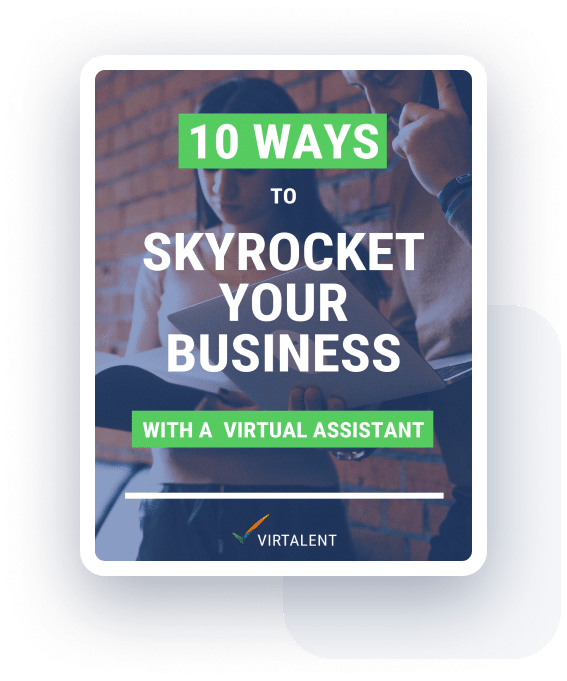Ah, a brand new year. A time to reflect on the one that’s just gone by, and a time to think about what we want for the one ahead. And time is what you need if you want to achieve all those resolutions you just made. Learning how to delegate effectively to your Virtual Assistant is one resolution that will give you just that.
So what’s on your list?
We’d hazard a guess that as an entrepreneur or small business owner, your resolution list includes a few things like this, in no particular order:
- Eat better
- Exercise more
- Spend more time with family and friends
- Grow my business
In a world where we are more connected, more stressed, more driven to succeed than ever before, it’s no surprise that what we all crave above anything else is more time. More time to look after ourselves, our health, our wellbeing, more time to spend with those we love, and more time to grow the businesses we are passionate about.
So is 2024 going to be the year you find more time to accomplish the things you really want to accomplish?
Set yourself up for success
We can’t make the day any longer, nor would we want to frankly. But we can offer you a little insight into how to get back some of the hours you do have. To give you a fighting chance of checking off some of those resolutions.
And it all comes down to this: learning how to delegate effectively.
Get Some Help In The Form Of A Virtual Assistant
But to learn how to delegate effectively, you need someone to delegate to. So our first suggestion would be to get a little support. Someone to help shoulder the burden, take on all those little jobs or projects that you can’t or don’t want to do.
But that sounds a bit scary doesn’t it?
Perhaps you aren’t ready to hire someone full time. Or you’re slightly terrified of the time consuming recruitment process. Or you’re put off by the financial risk of having an actual employee.
But it doesn’t have to be scary.
You could consider hiring a Virtual Assistant. Or perhaps you’ve already got one but aren’t really sure you know how to delegate effectively to them? So you need to master the art of delegation.
Why Is It So Important?
You’re busy. Your to-do list is enormous. There are so many other things you should be putting on it but you’re overwhelmed enough.
So you get a Virtual Assistant to take some of that stuff off your plate. But actually, when it comes down to it, it seems like doing it yourself is just quicker and easier, and you know exactly how you like it done, right?
Not knowing how to delegate effectively is a common problem. But it’s a simple one to fix with a little bit of know-how.
Integration
Your first step should be helping your Virtual Assistant to integrate into your business. For this you need a good onboarding process. It sounds scary but it’s not. You don’t need to be an HR expert. You’re already an expert on what’s important – and that’s you and your business.
Introductions
Introduce your Virtual Assistant to the rest of your team, even if that’s just your other half who sometimes does the invoices for you. You could use Skype or Facetime, or set up a chat group on Whatsapp. The important thing is that you make your new Virtual Assistant feel part of the team.
Overview
Give your Virtual Assistant a solid overview of you and your business – some background, purpose, goals, how you got started, why you do what you do etc. Help them understand your motives and where you want to get to. If they feel invested in your ambitions, they’ll become their ambitions too.
Practicalities
Have everything set up for them on their first day. Create a company email address, add them to the systems and software they’ll need access to, send them the login details, make sure they are familiar with everything they’ll need to use, and provide training if they’re not.
Expectations
Clearly communicate your expectations. Let them know what they can expect from you, what you expect from them, how you’ll check-in, give feedback, how you like to communicate. And don’t forget to give them a chance to ask any questions they may have.
How To Delegate Effectively

So now they’re fully onboarded and as a bonus you have everything in place for when your growing business hires it’s next person. Now you need to delegate.
Sure, you could just fire off a list and leave them to get on with it. But if you really want to reap the rewards, we’d recommend investing a little more time and effort.
Step 1: Figure out what to delegate
Make a list of everything you typically do and sort it into two columns. The one one with all those things that you shouldn’t really be doing, can’t do, or that are too low value for you to be doing is your Virtual Assistant’s new to-do list.
Step 2: Categorise all those tasks and projects
But don’t just send them that list. Look through it and categorise every item on it. A good starting point is:
- One-off tasks – might include event planning or website updates perhaps
- Recurring tasks – could be invoicing, inbox management, social media
- Ad hoc tasks – arranging the odd bit of travel you do every now and then
For recurring tasks you’ll need process manuals. If you don’t have them you can ask your VA to create them as they learn. This may sound counter-intuitive but they aren’t just for your Virtual Assistant to follow. These processes will help you to check how they’re getting on so make sure they include quality standards. And of course, they can be used in the future as your business grows.
Step 3: Invest time in training
Taking time out of your already busy day to train your Virtual Assistant may seem like just one more thing to add to your to-do list, but if you want to get some of your precious time back, if you want to actually find the time to fit in that daily run, or to get home before your kids go to bed, then you need to invest time in training them.
It will probably feel painful at first and there will undoubtedly be times that you’re tempted to just do that research project yourself, but there is a learning curve with all new employees, and a Virtual Assistant is no different.
Training them properly is the only way they will become proficient at their job. Which is the only way you will really benefit.
Step 4: how to delegate effectively
Now let’s get them off your to-do list and onto theirs. But again, don’t just email them that newly categorised list. Investing a little time now will pay dividends in the future.
For each task or project be clear about the deliverables and what you want to achieve. Set deadlines and regular times to check in on progress – what have they accomplished so far, have they got any questions, have they encountered any problems, how can you help?
Make sure you keep communication channels open and be approachable. Always give feedback, reviewing based on the quality standards you originally set out.
A few tips for success
There are a few tips we have picked up along the way.
Build the relationship – ask about their weekend, their new baby, remember when it’s their birthday. Do what you would do if they were sat next to you in that shiny office block in London that you used to work in. Build the relationship.
Learn to let go – perhaps they aren’t doing it the way you would, or as quickly, or they’re making a few mistakes along the way. Recognise that it took you time to learn how to do it as well as you do, and afford them to the chance to improve. Learn to let go.
Trust them – believe in them, their abilities, empower them, and support their decisions. Trust them.
Technology that can help
There is an app for everything these days. When it comes to working remotely, technology is what enables integration and communication. We found this great round up of remote working software.
There is also some great task management apps that will help you learn how to delegate effectively and stay on top of all those projects and tasks.
We have also put together a handy Roadmap To Delegation guide, which can help you lay everything out in a clear and easy format.
What will you do with all that extra time?

So you’ve got yourself some help, you’ve devised an onboarding process that you can use again and again as your business grows, you’ve sorted through that to do list, you’ve delegated everything you can delegate, and you’ve clawed back some precious hours in your day.
Now what are you going to do with them?
You can focus on what really matters, on what only you can do, and that’s growing your business. You could build a solid marketing strategy for the year, perhaps flesh out that sales plan, or start working on a new product or service.
Grow your business. Check.
Maybe you’re even confident enough to sign up for that gym membership now you feel like you might actually have time to go.
Exercise more. Check.
Perhaps you’ll start cooking healthy meals instead of grabbing a takeaway now that you’re not working until 9pm.
Eat better. Check.
You could even meet your friends for dinner one night, or get home in time to read your daughter’s bedtime story, or go to that birthday party on Saturday because you no longer have to spend all weekend working.
Spend more time with family and friends. Check.







